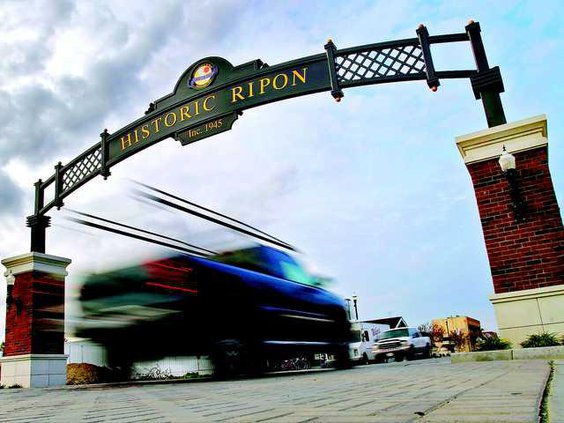Interlocking concrete permeable pavers — such as those used in downtown Ripon — could provide Manteca with a way to reduce long-term street maintenance costs.
The use of such pavers is part of an extensive public works presentation to the City Council on street maintenance, potential improvement projects, and funding during Tuesday’s 7 p.m. meeting at the Civic Center, 1001 W. Center St.
Staff has identified the Mayors’ Park neighborhood bounded by Louise Avenue, Union Road, and the railroad tracks as well as Springtime Estates bordered by Louise Avenue, Main Street and Highway 99 as concrete paver pilot projects in Manteca.
Ripon street paver projects as well as a pavers on Howard Road — a route with heavy truck traffic in Wesley off Interstate 5 — have been cited by the Interlocking Concrete Pavement Institute as two examples of how pavers hold up much better in the long haul and therefore have lower lifetime costs than asphalt.
While asphalt or concrete is less expensive to install — $45 per square yard as opposed to concrete pavers at $68 per yard — over an equal life cycle the asphalt approach the city currently uses is significantly higher. The long-term maintenance costs for asphalt or concrete is $66 per square yard as opposed to $12 for concrete pavers.
That means over the same time period, it costs a city $80 per square yard to install and maintain interlocking concrete pavers as opposed to $111 for asphalt or traditional concrete pavement. The $31 per square yard savings is significant.
The cost savings was the driving force for elected leaders in Ripon adopting interlocking concrete pavement as a roadway standard for 1.3 million square feet of new residential streets constructed between 2005 and 2008. The higher cost of the pavers was transferred to buyers of new homes.
In terms of the 5,555 square yards of pavers on downtown Ripon streets, that city will avoid $172,222 in maintenance costs over the life cycle of the streets.
Advantages the Manteca public works report cites besides lower overall costs are:
usimplified utility trenching as pavers can be replaced seamlessly unlike when asphalt has been ripped up and then replaced to access buried sewer, water, storm, power, natural gas, cable, and telephone lines.
ureduced storm water runoff as the permeable design allows some water to percolate into the ground. That provides additional benefits in less storm water that can add to flooding concerns as well as avoiding some of the costly solutions the federal government is requiring for storm water run-off in the coming years.
uproven results of being able to hold up on heavily traveled streets and frontage roads.
Other sources cite pavers as being significantly less susceptible to potholes as well as greatly reducing or eliminating issues associated with buckling and cracks developing.
Manteca currently has 461 lane miles of streets that it is struggling to find adequate funding to maintain.
To contact Dennis Wyatt, email dwyatt@mantecabulletin.com
BETTER THAN ASPHALT
Manteca will employ concrete pavers in Mayors Park, Springtime Estates





